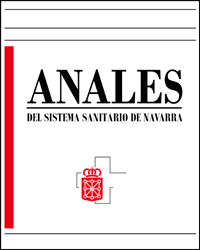Validation of the Scale of Hope in Terminal Illness for relatives brief version (SHTI-b). Validity and reliability analysis
DOI:
https://doi.org/10.23938/ASSN.0118Keywords:
"palliative care" "hope" "psychometric" "spirituality" "beliefs"Abstract
Background. Bermejo and Villacieros’ Scale of Hope in Terminal Disease (SHTD) specifically collects meanings of hope facing terminal disease, including considerations relating to psycho-emotional support and that have a transcendental sense. The objective of this paper is to validate the SHTD abbreviated and rephrased to adapt all the items to a single domain.
Methods. Starting from the published SHTD, an exploratory factor analysis (EFA) was carried out with a sample of 177 valid questionnaires. In a second study, with another sample of 180 valid questionnaires, a confirmatory factor analysis (CFA) and a correlation analysis with other measurements of spiritual wellbeing (Functional Assessment of Chronic Illness Therapy-Sp) and hope (Herth Hope Index) were done.
Results. A bidimensional model with satisfactory goodness of fit index values was obtained (GFI = 0.991; CFI = 0.984; SRMR = 0.08; RMSEA = 0.057); the Relations of Transcendence factor obtained a Cronbach’s alpha of 0.872 and Personal Relations an alpha of 0.762. The correlations of the SHTI-rb with external measures were: r = 0.527with FACIT; r = 0.266 with HHI; r = 0.667 with the Spirituality subscale of FACIT; and r = 0.348 with the Interrelation factor of HHI. The Relations of Transcendence subscale correlated with both Layout and Expectation and Interrelation of HHI (r = 0.162 and r = 0.329 respectively), while the scale of Personal Relations only correlated with Interrelation of HHI (r = 0.244).
Conclusions. The Scale of Hope in Terminal Illness for relatives (brief version) is a valid and reliable specific instrument for terminal patients.
Downloads
References
SNYDER C R. Handbook of hope: Theory, measures, and applications. San Diego: Academic Press, 2000.
PETERSON C, SELIGMAN ME. Character strengths and virtues: A handbook and classification. New York: DC: American Psychological Association, 2004.
SNYDER CR, ILARDI SS, CHEAVENS J, MICHAEL ST, YAMHURE L, SYMPSON S. The role of hope in cognitive-behavior therapies. Cognit Ther Res 2000; 24: 747-762.
CASSARETTO, M, MARTÍNEZ P. Validación de la Escala del Sentido del Humor en estudiantes universitarios. Revista de Psicología 2009; 27: 127-145.
CARR A.Psicología positiva: la ciencia de la felicidad. Barcelona: Paidós, 2007.
HERTH K. Fostering hope in terminally-ill people. J Adv Nurs 1990; 15: 1250-1259.
HERTH K. Development and renement or an instrument to measure hope. Sch Inq Nurs Pract 1991; 5: 39-51.
HERTH K. Abbreviated instrument to measure hope: development and psychometric evaluation. J Adv Nurs 1992; 17: 1251-1259.
HERTH K. Hope in the family caregiver of terminally ill people. J Adv Nurs 1993; 18: 538-548.
CHAN K, LI H, CHAN S, LOPEZ V. Herth Hope Index: psychometric testing of the Chinese version. J Adv Nurs 2012; 68: 2079-2085.
SARTORE A, ALVES S, HERTH K. Cultural adaptation and validation of the Herth Hope Index For Portuguese language: study in patients with chronic illness. Enfermagem 2010; 19: 754-761.
RIPAMONTI CI, BUONACCORSO L, MARUELLI A, BANDIERI E, BOLDINI S, PESSI MA et al. Hope Herth Index (HHI): a validation study in Italian patients with solid and hematological malignancies on active cancer treatment. Tumori 2012; 98: 385-392.
VAN GESTEL-TIMMERMANS H, VAN DEN BOGAARD J, BROUWERS E, HERTH, K, VAN NIEUWENHUIZEN C. Hope as a determinant of mental health recovery: a psychometric evaluation of the Herth Hope Index-Dutch version. Scand J Caring Sci 2010; 24: 67-74.
BENZEIN E, BERG A. The Swedish version of Herth Hope Index: An instrument of palliative care. Scand J Caring Sci 2003; 17: 409-415.
BENITO E, BARBERO J, PAYÁS A. El acompañamiento espiritual en cuidados paliativos: una introducción y una propuesta. Madrid: Arán, 2008.
BERMEJO HIGUERA JC, VILLACIEROS DURBÁN M. Componentes de la esperanza en situación de terminalidad: estudio de desarrollo de una escala de medida. Gerokomos 2016; 27: 97-103.
BERMEJO JC, VILLACIEROS M, SASTRE P, LOZANO B, MARTÍN E. Estudio de los factores que subyacen a la esperanza en la terminalidad. Congreso Nacional de la Sociedad Española de Cuidados Paliativos (SECPAL). Madrid, 2014.
CELLA D. FACIT-Sp-12-NonIllnes: Evaluación Funcional para el Tratamiento de Enfermedades Crónicas - Bienestar Espiritual, una Versión modificada para personas sanas. Med Care 1998; 36: 1407-1418.
CASTILLA H, URRUTIA CM, SHIMABUKURO M, CAYCHO T. Psicología desde el Caribe 2014; 31: 187-206.
NUNNALLY JC, BERSTEIN IH. Psychometric theory. 3th ed. New York: McGraw-Hill, 1994.
JÖRESKOG KG. Some contributions to maximum likelihood factor analysis. Psychometrika 1967; 32: 443-482.
BECK AT, WEISSMAN A, LESTER D, TREXLER L. The measurement of pessimism: the hopelessness scale. J Consult Clin Psychol 1974; 42: 861-865.
ROSENFELD B, BREITBART W, STEIN K, FUNESTI-ESCH J, KAIM M, KRIVO S et al. Measuring desire for death among the medically ill: the schedule of attitudes towards hastened death. Am J Psychiatry 1999; 156: 94-100.
Downloads
Published
How to Cite
Issue
Section
License
Copyright (c) 2017 Anales del Sistema Sanitario de Navarra

This work is licensed under a Creative Commons Attribution-ShareAlike 4.0 International License.
La revista Anales del Sistema Sanitario de Navarra es publicada por el Departamento de Salud del Gobierno de Navarra (España), quien conserva los derechos patrimoniales (copyright ) sobre el artículo publicado y favorece y permite la difusión del mismo bajo licencia Creative Commons Reconocimiento-CompartirIgual 4.0 Internacional (CC BY-SA 4.0). Esta licencia permite copiar, usar, difundir, transmitir y exponer públicamente el artículo, siempre que siempre que se cite la autoría y la publicación inicial en Anales del Sistema Sanitario de Navarra, y se distinga la existencia de esta licencia de uso.








